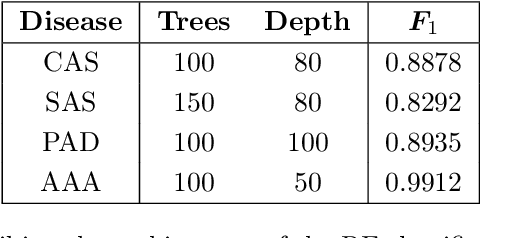Machine learning for detection of stenoses and aneurysms: application in a physiologically realistic virtual patient database
Paper and Code
Mar 11, 2021



This study presents an application of machine learning (ML) methods for detecting the presence of stenoses and aneurysms in the human arterial system. Four major forms of arterial disease -- carotid artery stenosis (CAS), subclavian artery stenosis (SAC), peripheral arterial disease (PAD), and abdominal aortic aneurysms (AAA) -- are considered. The ML methods are trained and tested on a physiologically realistic virtual patient database (VPD) containing 28,868 healthy subjects, which is adapted from the authors previous work and augmented to include the four disease forms. Six ML methods -- Naive Bayes, Logistic Regression, Support Vector Machine, Multi-layer Perceptron, Random Forests, and Gradient Boosting -- are compared with respect to classification accuracies and it is found that the tree-based methods of Random Forest and Gradient Boosting outperform other approaches. The performance of ML methods is quantified through the F1 score and computation of sensitivities and specificities. When using all the six measurements, it is found that maximum F1 scores larger than 0.9 are achieved for CAS and PAD, larger than 0.85 for SAS, and larger than 0.98 for both low- and high-severity AAAs. Corresponding sensitivities and specificities are larger than 90% for CAS and PAD, larger than 85% for SAS, and larger than 98% for both low- and high-severity AAAs. When reducing the number of measurements, it is found that the performance is degraded by less than 5% when three measurements are used, and less than 10% when only two measurements are used for classification. For AAA, it is shown that F1 scores larger than 0.85 and corresponding sensitivities and specificities larger than 85% are achievable when using only a single measurement. The results are encouraging to pursue AAA monitoring and screening through wearable devices which can reliably measure pressure or flow-rates
 Add to Chrome
Add to Chrome Add to Firefox
Add to Firefox Add to Edge
Add to Edge